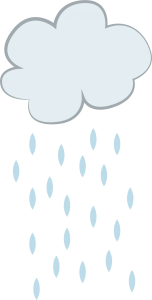Indirect Sunlight
On a cloudy day, many people think that solar panels don’t produce any solar energy. They often believe that panels require direct and full sunlight. However, this is not the case! Although they are less efficient when it is cloudy, solar panels can still harness sunlight on a cloudy day.
Clouds
Even where there are clouds in the sky, sunlight still reaches the earth’s surface. Think about it: it can still be an 80-degree day even when it is cloudy! Some sunlight may be blocked by clouds, but there is still enough to heat the earth’s surface. Solar panels work the same way. In indirect sunlight, solar panels can still take the available sunlight and convert it to electricity. It will take them longer to produce a fixed amount of energy, but the panels still have the capacity to produce some solar power.
Rain
On a rainy day, solar panels are less efficient due to a lack of direct sunlight. However, indirect sunlight still reaches the panels, so these panels still convert the current from the sun into electricity. Additionally, rain can clean the solar panels by washing off dust. This can actually increase efficiency in the long term! Lastly, with rain and clouds often comes cooler weather. Solar panels are more efficient in slightly cooler weather rather than heat. For more information on solar panels in warm weather, visit this blog post.
Shade
Solar panels operate at reduced capacity when they are completely in the shade. Luckily, it is unlikely that shade will completely cover your solar panel system. Here at SGE we complete a shade report to assess a roof before installing the solar panel system. We also determine if any trees need to be cut down to get full sun on the roof. So, all the systems that we install will have minimized inefficiency due to shading.
Inverters
The efficiency of a solar panel system in the shade also depends on the type of inverter used. Systems that use string inverters are less efficient in the shade. This is because in string inverter systems, current from each panel runs through one central inverter. So, if one panel is in the shade, then all the panels connected to this inverter will function at reduced capacity. In contrast, microinverters or power optimizer systems convert current at an individual panel level. So, if one panel is shaded, only the output of this panel is affected and the rest of the panels still operate at full capacity.
Luckily, the two main inverters that we install (Enphase and SolarEdge) are efficient in the shade. Enphase inverters are microinverters, and SolarEdge uses a string inverter + power optimizer system. For a more detailed explanation of how inverters work, visit this page on our website.
Overall, solar panels still work in indirect sunlight! Just think of countries like Germany – they are known for being leaders in solar energy, yet they receive less sun overall than the United States. This proves that full sun every day is not necessary to successfully produce your own solar energy.
If you are still concerned about meeting your electricity needs on a cloudy day, consider solar battery storage. Solar batteries allow you to store solar energy to use on days with less sunlight. If you have any more questions or concerns, give us a call or reach out to us through our contact page.



